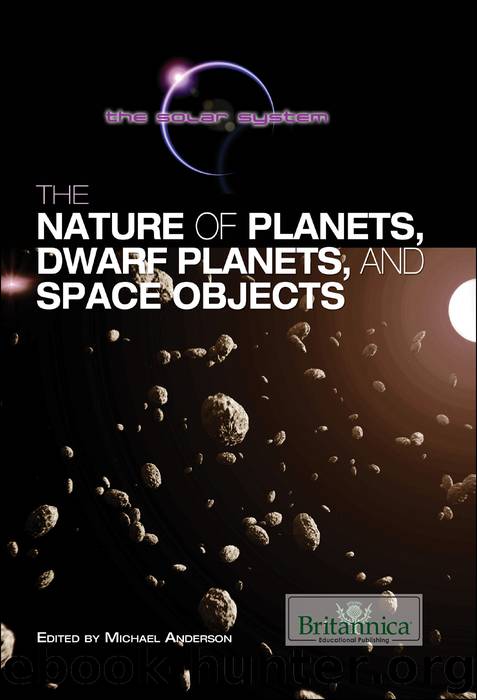The Nature of Planets, Dwarf Planets, and Space Objects by Britannica Educational Publishing

Author:Britannica Educational Publishing
Language: eng
Format: epub
Publisher: Britannica Educational Publishing
Published: 2012-03-14T16:00:00+00:00
Bright and dark regions on Pluto’s surface appear in a map based on images taken by the Hubble Space Telescope. The north polar region generally has bright areas, while the equatorial region, particularly to the south, has more dark patches. The map is a Mercator projection; the blue tint was added in reproduction. Encyclopædia Britannica, Inc.
Pluto’s surface has both bright and dark regions. Overall, it reflects about 55 percent of the light that reaches it. In comparison, Earth’s Moon reflects only about 10 percent of the light it receives, while icy Triton reflects about 80 percent, as ice is highly reflective. Pluto’s fairly high reflectivity suggests that its surface consists partly of ices and partly of something else. The brighter regions seem to be mostly frozen nitrogen, with some frozen methane, water ice, and frozen carbon monoxide. The area around Pluto’s south pole is especially bright. Little is known about the darker regions of the surface, which are somewhat reddish. It is thought that they contain some mixture of organic compounds.
Because it is so far from the Sun, Pluto receives only about of the amount of sunlight that Earth does, on average. Its surface is extremely cold. Different types of observations have suggested that the surface temperature may be about −355 °F to −397 °F (−215 °C to −238 °C). The temperature probably varies seasonally, and the brighter areas must be generally colder than the darker ones.
Pluto is thought to be made of more than half rock, with the rest ice, probably water ice. Scientists think its interior may have separated into layers, with a rocky core surrounded by a mantle of water ice, but more information is needed.
Download
This site does not store any files on its server. We only index and link to content provided by other sites. Please contact the content providers to delete copyright contents if any and email us, we'll remove relevant links or contents immediately.
Tools of Titans by Timothy Ferriss(7813)
Turbulence by E. J. Noyes(7700)
Astrophysics for People in a Hurry by Neil DeGrasse Tyson(5001)
Secrets of Antigravity Propulsion: Tesla, UFOs, and Classified Aerospace Technology by Ph.D. Paul A. Laviolette(4992)
Design of Trajectory Optimization Approach for Space Maneuver Vehicle Skip Entry Problems by Runqi Chai & Al Savvaris & Antonios Tsourdos & Senchun Chai(4841)
Room 212 by Kate Stewart(4736)
Pale Blue Dot by Carl Sagan(4615)
The David Icke Guide to the Global Conspiracy (and how to end it) by David Icke(4380)
A Journey Through Divination and Astronomy by Publishing Pottermore(4250)
Apollo 8 by Jeffrey Kluger(3512)
Goodbye Paradise(3446)
Losing the Nobel Prize by Brian Keating(3425)
COSMOS by Carl Sagan(3348)
The Five People You Meet in Heaven by Mitch Albom(3335)
How to Read Water: Clues and Patterns from Puddles to the Sea (Natural Navigation) by Tristan Gooley(3240)
Brief Answers to the Big Questions by Stephen Hawking(3239)
How to Read Nature by Tristan Gooley(3078)
The Order of Time by Carlo Rovelli(3073)
A Brief History of Time by Stephen Hawking(2819)
